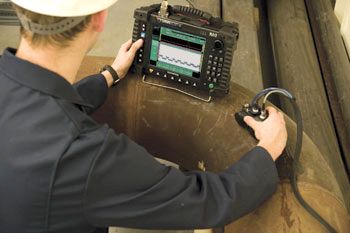Combined Phased Array and UT Instruments
Some phased array instruments also provide a conventional ultrasonic channel to support inspections with single element transducers. It is important to know how this conventional channel functions.
Pulser:Because of the small size of phased array elements, and leveraging the fact that constructive interference effects between elements results in higher sensitivity, phased array pulsers are typically limited to 100 volts. Often vendors use this limited phased array pulser as the conventional transducer pulser. This can become very limiting in applications involving long sound paths or highly attenuating materials, especially when using frequencies at or below 2.25MHz.
Image Support:While the phased array portion of the instrument supports A-scan, B-scan, C-scan, and sectorial scans, this does not mean the conventional UT portion of the instrument will necessarily incorporate any imaging. More capable instruments do allow cross sectional B-scans on a timed basis with waveform storage on the conventional side. Some also include the ability to interface with conventional transducers attached to one or two axis encoded scanners to generate
actual position related B-scans and C-scans respectively. Of course sectorial scanning is unique to phased array.
In the image below, a combined phased array/conventional instrument is working in conventional mode. performing a B-scan of a corroded pipe with a dual element transducer in an encoded hand scanner.

Continue on to
Anatomy of Phased Array Display >>